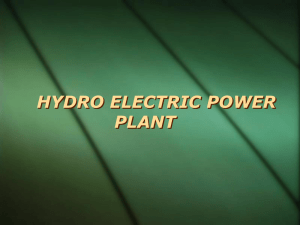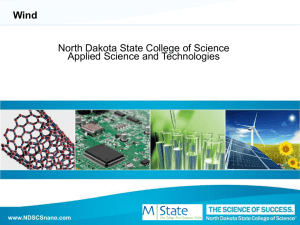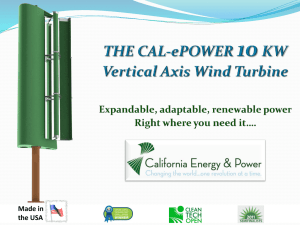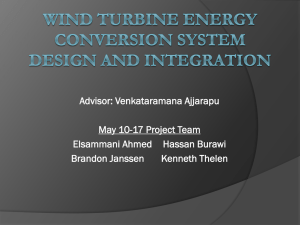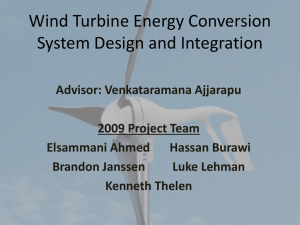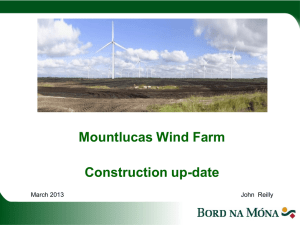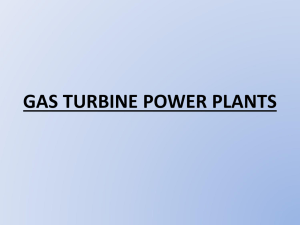Power Plant Primer - Combustion Turbines
advertisement
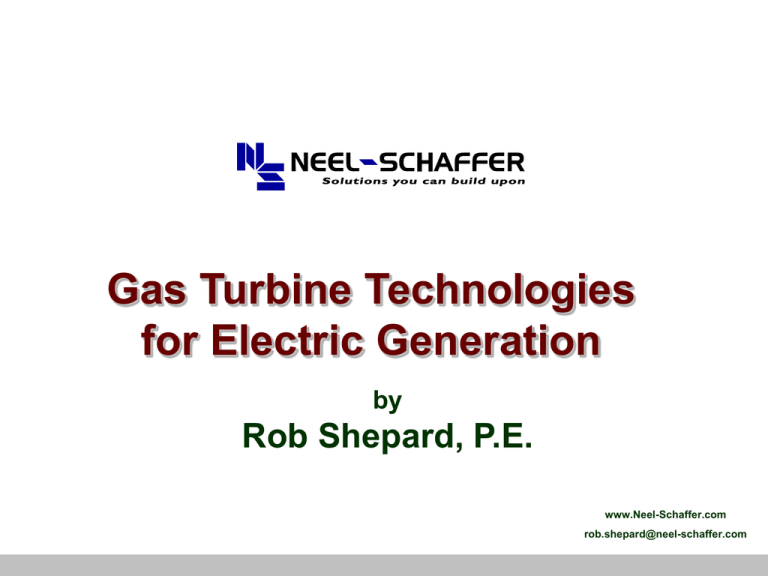
Gas Turbine Technologies for Electric Generation by Rob Shepard, P.E. www.Neel-Schaffer.com rob.shepard@neel-schaffer.com Gas Turbine Basics Gas Turbines 2 Types How They Work Applications Components of Plant Flow Paths Operation Gas Turbine Applications Simple Cycle Combined Cycle Cogeneration 3 Types of Gas Turbine Plants Simple Cycle Operate When Demand is High – Peak Demand Operate for Short / Variable Times Designed for Quick Start-Up Not designed to be Efficient but Reliable Combined Cycle 4 Not Cost Effective to Build for Efficiency Operate for Peak and Economic Dispatch Designed for Quick Start-Up Designed to Efficient, Cost-Effective Operation Typically Has Ability to Operate in SC Mode Principles of Operation Open Cycle Also referred to as simple cycle) The energy contained in a flowing ideal gas is the sum of enthalpy and kinetic energy. Pressurized gas can store or release energy. As it expands the pressure is converted to kinetic energy. Link to picture 5 Brayton Cycle – Gas Turbine Cycle 6 Thermodynamic Fundamentals Pressure Ratio & CT Components 7 Combustion or Gas Turbine 8 Principles of Operation Compressor As air flows into the compressor, energy is transferred from its rotating blades to the air. Pressure and temperature of the air increase. Most compressors operate in the range of 75% to 85% efficiency. Combustor The purpose of the combustor is to increase the energy stored in the compressor exhaust by raising its temperature. Turbine The turbine acts like the compressor in reverse with respect to energy transformation. Most turbines operate in the range of 80% to 90% efficiency. 9 Principles of Operation Overall Energy Transformations (Thermal Efficiency) Useful Work = Energy released in turbine minus energy absorbed by compressor. The compressor requires typically approximately 50% of the energy released by the turbine. Overall Thermal Efficiency = Useful Work/Fuel Chemical Energy *100 Typical overall thermal efficiencies of a combustion turbine are 20% - 40%. 10 Gas Turbine Applications Simple Cycle Link to picture 11 Simple Cycle Power Plant Westinghouse 501D5 – 340 MW 12 Combined Cycle Power Plant 13 Combined Cycle Plant Design GT PRO 13.0 Drew Wozniak 12.54 p 90 T 30 %RH 944 m 4327 ft elev. Net Power 95959 kW LHV Heat Rate 7705 BTU/kWh 967.3 m 1X GE 6581B 149.2 p 684 T Fogger 4.717 m 143.2 p 2072 T 2 X GT 73.85 %N2 13.53 %O2 3.233 %CO2+SO2 8.497 %H2O 0.8894 %Ar 12.93 p 1034 T 1934.6 M 33781 kW 12.39 p 68 T 948.7 m 30813 kW Natural gas 18.58 m LHV 369671 kBTU/h 77 T 122 T 292.6 M 122 T 850 p 950 T 248.6 M 96 T 1.694 p 120 T 222.1 M 17.19 p 220 T 292.6 M 29.65 M 29.58 M 0.1296 M 26.36 M 195.8 p 597 T 6.89 M 879.8 p 954 T V4 183 p 375 T 70 M 120 T V8 6.89 M FW LPB IPE2 IPB HPE2 IPS1 HPE3 IPS2 HPB1 HPS3 268 T 1934.6 M 1031 T 1934.6 M 17.19 p 220 T 29.65 M 268 203.6 p 373 T 292.6 M 326 p[psia], T[F], M[kpph], Steam Properties: Thermoflow - STQUIK 14 1512 10-13-2004 23:27:31 file=C:\Tflow13\MYFILES\3P 0 70.gtp 203.6 p 924.2 p 383 T 472 T 36.75 M 251.1 M 419 481 534 199.7 p 910.5 p 460 T 523 T 36.75 M 251.1 M 538 568 195.8 p 910.5 p 500 T 533 T 36.75 M 248.6 M 569 879.8 p 954 T 248.6 M 897 1031 Natural gas 0M Gas Turbine Components Compressor – Combustor - Turbine 15 Gas Turbine Components & Systems (cont’d) Combustion System Multiple Shaft, Single Shaft Number of Stages Material and Manufacturing Processes Exhaust System Silo, Cannular, Annular Water, Steam, DLN Turbine Generator Simple Cycle Stack Transition to HRSG Open-Air cooled TEWAC Hydrogen Cooled Starting Systems Diesel Motor Static Paper Towel thru compressor 16 Combustion Turbine Fuels Conventional Fuels Nonconventional Fuels Crude Oil Refinery Gas Propane Synthetic Fuels 17 Natural Gas Liquid Fuel Oil Chemical Process Physical Process GE Combustion Turbine Comparisons 18 Gas Turbine Types Advanced Heavy-Duty Units Advanced Aeroderivative Units Parameter Capital Cost, $/kW Heavy Duty Aero-Derivative Lower Higher 10 - 330 5 – 100 Efficiency Lower Higher Plan Area Size Larger Smaller Maintenance Requirements Lower Higher Technological Development Lower Higher Capacity, MW 19 Gas Turbine Major Sections Air Inlet Compressor Combustion System Turbine Exhaust Support Systems 20 Gas Turbine Barrier Inlet Filter Systems 21 Gas Turbine Pulse Inlet Filter System 22 Inlet Guide Vanes 23 Inlet Guide Vanes 24 Gas Turbine Compressor Rotor Assembly 25 6B Gas Turbine 26 Gas Turbine Cut Away Side View 27 Gas Turbine Combustor Arrangement 28 Frame 5 GT 29 GE LM2500 Aeroderivative Gas Turbine Compressor 30 Compressor Turbine Section Power Turbine Section FT4 Gas Turbine 31 FT4 Gas Turbine – Gas Generator (Compressor) 32 FT4 Gas Turbine – Gas Generator (Compressor) 33 FT4 Gas Turbine – Free Turbine 34 FT4 Gas Turbine – Free Turbine Gas Path 35 FT4 Gas Generator Performance 36 FT4 Free Turbine Performance 37 Aeroderivative Versus Heavy Duty Combustion Turbines Aeroderivatives 38 Higher Pressure Ratios and Firing Temperatures Result in Higher Power Output per Pound of Air Flow Smaller Chilling/Cooling Systems Required Compressor Inlet Temperature Has a Greater Impact on Output and Heat Rate Benefits of Chilling/Cooling Systems are More Pronounced Typical Simple Cycle CT Plant Components 39 Prime Mover (Combustion Turbine) Fuel Supply & Preparation Emissions Control Equipment Generator Electrical Switchgear Generator Step Up Transformer Starting System (Combustion Turbines) Auxiliary Cooling Fire Protection Lubrication System Typical Peaking Plant Components Lube Oil System Switchgear / MCC 40 GSU Generator Starting Engine Fire Protection Combining the Brayton and Rankine Cycles Gas Turbine Exhaust used as the heat source for the Steam Turbine cycle Utilizes the major efficiency loss from the Brayton cycle Advantages: Relatively short cycle to design, construct & commission Higher overall efficiency Good cycling capabilities Fast starting and loading Lower installed costs No issues with ash disposal or coal storage Disadvantages 41 High fuel costs Uncertain long term fuel source Output dependent on ambient temperature How does a Combined Cycle Plant Work? Picture courtesy of Nooter/Eriksen 42 Combined Cycle Heat Balance 43 Combined Cycles Today Plant Efficiency ~ 58-60 percent Steam Turbine output up to 750 MW for 3 on 1 configuration Up to 520 MW for 2 on 1 configuration Construction time about 24 months Engineering time 80k to 130k labor hours Engineering duration about 12 months Capital Cost ($900-$1100/kW) Two (2) versus Three (3) Pressure Designs 44 Typically 50% of the gas turbine output More with duct-firing Net Plant Output (Using Frame size gas turbines) Biggest losses are mechanical input to the compressor and heat in the exhaust Larger capacity units utilize the additional drums to gain efficiency at the expense of higher capital costs Combined Cycle Efficiency Simple cycle efficiency (max ~ 44%*) Combined cycle efficiency (max ~58-60%*) Correlating Efficiency to Heat Rate (British Units) --> 3412/h = Heat Rate* – 3412/.44 = 7,757 Btu/Kwh* – 3412/.58 = 5,884 Btu/Kwh* Correlating Efficiency to Heat Rate (SI Units) h= 3412/(Heat Rate) Simple cycle Combined cycle h= 3600/(Heat Rate) Simple cycle Combined cycle --> 3600/h = Heat Rate* – 3600/.44 = 8,182 KJ/Kwh* – 3600/.58 = 6,207 KJ/Kwh* Practical Values HHV basis, net output basis Simple cycle 7FA (new and clean) 10,860 Btu/Kwh (11,457 KJ/Kwh) Combined cycle 2x1 7FA (new and clean) 6,218 Btu/Kwh (6,560 KJ/Kwh) *Gross LHV basis 45 Gas Turbine Generator Performance Factors that Influence Performance Fuel Type, Composition, and Heating Value Load (Base, Peak, or Part) Compressor Inlet Temperature Atmospheric Pressure Inlet Pressure Drop Exhaust Pressure Drop 46 Affected by addition of HRSG, SCR, CO catalysts Steam or Water Injection Rate Varies significantly with types of air cleaning/cooling Used for either power augmentation or NOx control Relative Humidity Altitude Correction 47 Humidity Correction 48 Cogeneration Plant A Cogeneration Plant Typical thermal hosts paper mills, chemical plants, refineries, etc… potentially any user that uses large quantities of steam on a continuous basis. Good applications for combined cycle plants 49 Power generation facility that also provides thermal energy (steam) to a thermal host. Require both steam and electrical power Major Combined Cycle Plant Equipment 50 Combustion Turbine (CT/CTG) Steam Generator (Boiler/HRSG) Steam Turbine (ST/STG) Heat Rejection Equipment Air Quality Control System (AQCS) Equipment Electrical Equipment Heat Recovery Steam Generator (HRSG) 51 Steam Turbine GE D11 52 Heat Rejection Equipment - Condenser Same Function as discussed earlier in Session 9 53 Usually utilizes a cooling tower to reject heat to the atmosphere Rarely uses once through cooling (retrofit applications or ocean) Questions? Rob Shepard Neel-Schaffer, Inc. www.Neel-Schaffer.com rob.shepard@neel-schaffer.com 54

